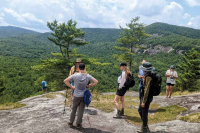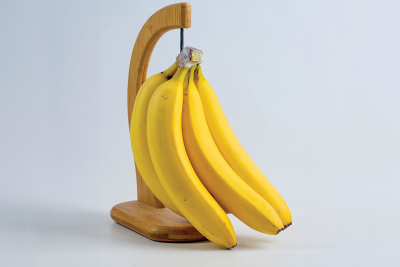Jockeying for space on the Nantahala: Outfitters and summer camps spar over control of river traffic
Rafting outfitters in the Nantahala Gorge have arrived at a compromise with summer camps and colleges vying for the chance to take kids down the Nantahala River without going through an existing commercial outfitter.
The U.S. Forest Service issues only a limited number of permits for commercial traffic on the river. Camps and colleges that don’t have a permit but want to take their kids paddling have to sign up for a trip with one of the outfitters.
A coalition of summer camps and colleges want to use their own staff, however, which often includes experienced paddlers, and avoid paying a commercial outfitter for the service of a down-river escort. They asked the forest service to up the number of permits issued on the river, setting off a months-long debate over how to balance demand on the Nantahala.
During the thick of summer tourist season, outfitter traffic on the Nantahala is akin to finely tuned, well-oiled clock gears.
An average of 200,000 people a year ran the Nantahala over the last five years — most of that crammed into a mere three months. Between 85 and 90 percent of river traffic is with a commercial outfitter, according to the forest service.
Moving thousands of rafters on and off the river in a day is no small feat given the narrow road, dearth of parking and cramped put-ins and take-outs.
While Nantahala Outdoor Center has its own take-out on its property, the rest of the raft outfitters share two take-outs.
Guides must get their loads of giddy and adrenaline-pumped rafters to the shore, out of their boat, out of their life jackets, then onto a bus — plus the rafts strapped on top — within 10 minutes to make room for the next bus waiting in the wings.
“We all work together to make sure that we are not clogging these places up. We understand the importance to make sure things move smoothly. It is a concerted effort,” said Kevin Gibbs, CEO of Wildwater and president of the Nantahala Gorge Association, an affiliation of rafters.
The same goes for put-ins, which are equally short on space.
The forest service initially considered granting up to 36 new commercial permits — compared to the 16 they have now. Doing so would have also opened the door for new commercial outfitters — not just camps and colleges — to start doing business on the Nantahala.
Rafting outfitters feared an influx of camps, colleges and new commercial guides running their own trips down the river would create an untenable free-for-all.
Guides unaccustomed to the hustle of the river would clog up the works. And guides unfamiliar with the river’s more treacherous spots could also pose safety risks, the existing outfitters argued, pointing to Big Wesser Falls just downstream of the commercial take-out.
“If you miss the take-out, you are going to want to paddle really, really hard to get to shore because there is a very large rapid just below it that no one paddles commercially,” Gibbs said. “It is very difficult, and it can be very dangerous. That is one of our initial concerns.”
Yes to kayaks, no to rafts
After studying the issue for much of the last year, the forest service decided against new commercial permits for raft trips, it announced last week.
But the forest service did make a concession that pleases camps and colleges. The forest service will issue a dozen new permits for guided kayak and canoe trips on the river. The permits will only be good Monday through Thursday, however, avoiding the busy weekends. Group size and the number of trips a year are also limited for those seeking the new permits.
Mike Wilkins, chief forest ranger for the Nantahala District, said the facilities and infrastructure in the Gorge simply can’t accommodate more traffic.
“It is really hard to move lots of people in and out quickly,” Wilkins said.
Both the outfitters and camps say the decision strikes a balance between giving camps more flexibility to take their own kids down the river yet guarding against the type of mayhem outfitters feared.
“I think that Mike listened to everybody’s concerns, not just the folks interested in coming here but the folks who are already here,” Gibbs said.
Wilkins said he wasn’t exactly aiming for a compromise, although that’s what it’s being called.
“I don’t know about a compromise but I was trying to weigh all the factors,” Wilkins said. “I guess in my mind, I wasn’t as concerned about the purely recreational use as the ability to give young people instruction.”
Wilkins didn’t want to deny a summer camp from teaching its kids how to paddle on the river.
After all Sutton Bacon, the CEO of NOC, first learned how to kayak at summer camp.
“We can all personally attest to the value of being introduced to whitewater paddling on the Nantahala at a young age,” Bacon said. “To that end, NOC strongly supports the use of the Nantahala River by a wide variety of groups and camps that expose young people to whitewater paddle sports.”
Gordon Strayhorn, president of the N.C. Youth Camp Association, said the new permits should satisfy camps for the most part. Camps are primarily interested in taking their kids kayaking and canoeing anyway — not rafting, Strayhorn said.
Strayhorn, who is the head of Camp Illahee, said paddling has been part of their summer camp program for decades. “Organized youth summer camps have been using the Nantahala River for more than 60 years and represented the first recreational use of the river, long before permits and outfitters existed,” Strayhorn said.
They have forest service permits on every other river in the region — French Broad, Ocoee, Chattooga, Nolichucky and the Pigeon. The Nantahala was the only they couldn’t run with their own guides but instead had to go through a commercial outfitter, he said.
Strayhorn said the forest service was right to open up new permits on the Nantahala.
River squatters
One logistical concern still troubles the outfitters, however. Unlike the outfitters, camps and colleges don’t have a home base in the Gorge. Where will their van drivers park for three hours while their students run the river? Where will they change into dry clothes afterward? Where will they use the bathroom?
“Several business owners are concerned these people would come and stop at their outposts,” Gibbs said.
As the largest outfitter in the Gorge and with prime real estate on both sides of the river near the take-out, Nantahala Outdoor Center would likely be a prime target. NOC CEO Sutton Bacon doesn’t want their campus to become a staging area for other groups. Not when parking in the Gorge is at such a premium.
“Of course, we want to be as welcoming as possible, but it is also unfair to expect NOC to bear the entire burden of providing public access for all of these groups, especially if it means there is not enough parking for our own guests,” Bacon said.
That remains one of the biggest outstanding issues: what facilities will these groups use if they don’t go through an outfitters? Bacon said NOC is already getting queries from camps wondering whether they could use NOC as a staging area. But striking deals with up to a dozen individual camps or colleges would be challenging.
Bacon thinks a better solution would be giving an umbrella permit to the Youth Camp Association. NOC could then negotiate usage of its facilities with just one entity. And with one umbrella permit for all the camps, they could better divvy up use on the river to avoid all coming on the same day.
River economics
Outfitters downplayed their financial motive in opposing new commercial permits on the river. But they admitted that there is not an unlimited amount of rafting business on the river.
Wilkins said economic concerns among existing outfitters partly weighed into his decision not to allow new commercial raft companies but instead limit new permits to guided canoe and kayak trips. He realizes the existing outfitters have a lot at stake.
Outfitters made approximately $2.8 million on guided trips on the Nanty in fiscal year 2010, based on forest service data. The number only includes revenue on river trips — not T-shirts, food sales and other purchases rafters likely make.
Outfitters pay 3 percent of revenue made on guided trips to the forest service for a commercial permit.
Outfitters will obviously lose some revenue once camps can take their own kids down river. But Strayhorn said the economic benefits outweigh it.
“I don’t think camps being permitted on the river will negatively impact the economy of the region at all. I think it will improve it,” Strayhorn said.
Summer camps in Jackson, Buncombe, Transylvania and Henderson counties alone have a combined economic impact of $365 million, according to an economic impact study by N.C. State University, he said.
Out in the cold
The decision will essentially put an end to teaching trips the Carolina Canoe Club historically led on the Nantahala, according to Spencer Muse, president of the Carolina Canoe Club.
The Carolina Canoe Club holds paddling workshops and rescue training on the Nantahala River for its 1,000 members. Since participants pay to go on the trips, it counts as a commercial operation and thus needs a permit.
Supportive of the club’s mission, Nantahala Outdoor Center used to let the club do its trips under the auspice of NOC’s permit. But the forest service put an end to that three years ago.
Lacking a commercial permit of its own, Carolina Canoe Club stopped charging its members for the courses so it didn’t count as a commercial trip. But the club can’t indefinitely bear the cost of hosting the trips without being able to charge those who come, Muse said.
Muse said the handful of new permits the forest service has agreed to issue are useless for his group since they aren’t valid on weekends. The club has always done its trips on weekends — since the people going on them as well as the instructors have jobs.
Muse said the club only goes on two trips a year, and would be willing to do them outside the peak summer season, such as early May or mid-September, when crowding isn’t an issue.
“We are only talking about two weekends a year we use the Nantahala,” Muse said.
If they can’t find a solution, the club will likely move its paddling instruction weekends to the Gauley River.
“It is a little odd to have West Virginia be the location for Carolina Canoe Club’s main teaching activities,” Muse said.
How permits on the Nantahala work
Commercial outfitters must have a permit from the forest service to run raft trips on the Nantahala River. The same goes for a guide leading a group of kayakers — or even escorting a single kayaker for a paddling lesson — if money is exchanging hands.
But if your buddy owns a raft and offers to take you and a few friends on a trip down the Nanty and he doesn’t charge you for it, no commercial permit is required.
The number of outfitters on the river has dropped over the years, along with the number of permits. As outfitters have gone out of business, the forest service closed out their permit rather than opening it up to new takers.
Ten years ago, there were 21 commercial permits. Today, there are only 16.
Most permits are held by commercial raft companies, but a few do belong to institutions. Western Carolina University has a permit, for example, and is able to teach paddling to its students on the river without going through an outfitter.
By the numbers
12: outfitters based in the Gorge
16: permits to entities operating commercial trips on the river
200,000: people going down the river each year
90: percent of river traffic that goes through an outfitter
All in the design: NOC experts lend ideas on kayaks
When the new line of 2009 kayaks hits the outfitters’ stores in coming weeks, the mark of paddling guru Wayner Dickert will be lurking beneath more than one hull.
The former Olympic paddler has long been a go-to guy for boat manufacturers. In the trenches at Nantahala Outdoor Center’s paddling school where thousands flock every year to improve their skills, Dickert has a foot soldier’s view of the demands in the boat market.
Of all the boats Dickert consulted on this year, he’s most excited about a new boat by Dagger — the Karnali — named for a mega-river in Nepal. As a paddling instructor, Dickert’s constant challenge to boat makers is to design a kayak that strikes a balance between the mutually exclusive traits desirable to a beginner versus an expert. For example, beginners need a boat that’s stable, thus a flatter hull. But more rounder bottoms move better if you have the skills to handle them.
Another set of attributes that are mutually exclusive: a boat that’s stable when upright, yet easy to flip back up if you capsize.
The new Karnali by Dagger attempts to find the perfect balance of all these with the beginner in mind.
“It was literally built because of our instruction programs,” Dickert said. “We wanted a boat that was easy to paddle, easy to roll and still has great stability. They completely went back to the drawing board and built this boat really around a lot of the comments and recommendations that we had.”
The paddling companies often call on NOC staffers for input when crafting new boats.
“It is pretty common that a manufacturer will call or email and say ‘Hey, we are working on this. What do you think it ought to be?’” Dickert said.
Those called on for advice range from the paddling teachers to the outfitters store. And why not?
“We are the frontrunner for instruction in North America and probably put more people through courses than anybody possibly in the world,” said Robert Bone, NOC’s boat buyer.
As the guy who chooses which boats NOC buys, whether it’s for their rental fleet, for the paddling school or to stock in the outfitters store, Bone is another guy boat makers want to curry favor with.
“It’s a pretty common occurrence,” Bone said of NOC staffers consulting on new boat designs. “We’ve been involved in designing boats for 30 years. It is pretty neat to be thought of in the industry as the people they go to. That’s the cool thing about NOC, is we have that expertise and the manufacturers feel comfortable coming to us and asking what’s going to sell on the marketplace.”
Rival boats
The NOC staffers are equal opportunity consultants.
“Because we carry all the lines, we have a neutral perspective,” Dickert said. “We look at boats from the perspective of what will help our guests become the best paddler they can be.”
In other words, someone looking for a boat — whether to rent for the day or to buy — will be pointed toward the one that best suits their ability and interests out of all the available lines, not just the best out of Liquid Logic’s line, or from Jackson Kayaks’ line.
That means Dickert can be consulting for more than company at a time. On ’09 designs, Dickert lent his two cents to both Dagger and Pyranha. Unbeknownst to each other, both were working on similar tracks, although Dickert couldn’t reveal it until the boats were ready.
“They ended up being so similar that when they saw each other’s boats they said ‘Hey, that’s our boat,’” Dickert said. “They are still definitely different boats and each one has its own special micro niche it will fit into, but each others’ jaw dropped.”
It’s not uncommon for boat makers to head down similar paths, just like car makers or electronic makers come out with similar innovations the same year.
“They knew there was a need in the industry and they ended up getting to similar places to fill that need, so that means to me they called it pretty well,” Dickert said of Dagger’s new Axium and Pyranha’s new Zone.
Hands-on
In exchange for his input, Dickert hopes to earn a free boat when the line comes out. But occasionally, he lands a gig on a prototype team that sees a boat through from inception to the final product.
One such boat was the GT, an innovative boat developed by Dagger a few years ago. Dickert laid down the initial challenge — to find the perfect middle ground between the stability of a play boat and the maneuverability of the river running kayaks.
Here’s a crash course for the non-paddler: a play boat sports a shorter, stubbier, fatter snout good for bouncing around on waves, while a river runner is longer and sleeker. Each boat calls for a specific hull type. The river runner has a displacement hull with a rounded bottom for slicing through the water, while the play boat has a planing hull that’s flatter for sitting on top of the water.
“The challenge was finding a good balance to where you still got the benefit of that flat bottom hull,” Dickert said.
After some initial consultations with the designers, they built a few prototypes, and that’s when things got fun. Dickert and a team of three other paddlers hit the water with the prototypes, trading boats over the course of the day to get a feel for each.
“We would sit around and compare notes and say ‘What did you like about this, what did it do well, what did it not do well.’ We would figure out what needed to be changed and they would go back and try to make that happen,” Dickert said.
The team took each new set of prototypes out on the water, refining, refining, refining each time.
“When we got it on the water if it didn’t work out like we thought it would we’d say ‘Let’s change this,’” Dickert recounted. They went through upwards of 15 prototypes this way before Dagger cut them off.
“You try to keep getting it closer and closer, but it’s one of those things where at some point you have to draw a line,” Dickert said. “It is all a compromise.”
Dickert’s hard work was vindicated when the GT got Boat of the Year by Outside magazine that year.
Paddling industry pins hope on new designs to stoke interest
The new lines of kayaks and canoes this year have one mission in common: to lure new converts.
“Most of the manufacturers are coming out with boats that are more beginner and intermediate friendly. This is a push to get more people involved in paddling as new boaters have been declining for the past decade,” said Robert Bone, a boat expert at Nantahala Outdoor Center. “They realize we have to grow this market segment. To keep it viable for the manufacturers, they have to get new people involved, thus the new designs.”
There’s been a decline in paddling for the past eight years, Bone said. Thousands flock to NOC’s courses each year to learn how to paddle. But if newcomers can’t get the hang of it, at least enough see a light at the end of the tunnel, they give up.
“The learning curve is very steep in the first several years,” Bone said.
While it’s more fun for boat makers, who are often world-class paddlers themselves, to design high-power, high performance boats tailored to other experts like them, the NOC crew has help pushed designers into considering the beginners.
“For the beginning paddler you need something that gives them a lot of confidence on the river. They need to get on the river and feel like they can really do it and then they’ll come back and turn it into a life time sport, so that’s what I wanted to do more than anything,” said Wayner Dickert, a world-class paddler and instructor at NOC.
There’s a trade-off when designing a boat — a kayak with high maneuverability for experienced paddlers versus one more likely to stay upright. NOC staffers kept asking the manufacturers for a more forgiving boat, and they finally responded.
“It is nice to have the manufacturers listen to you and develop a boat for your specific market,” Bone said. “We really appreciate that.”
The boat companies are also pitching boats this year that can multi-task. The expert paddler has an arsenal of boats to fill every niche of water imaginable, whether it’s the best boat for making fast tracks on a lake or barreling over class V waterfalls on narrow creeks. Play boats are even tailored toward the type of trick they perform best for, with some handling best for enders and cartwheels and the others for stern squirts and spins.
Dickert has eight boats from that came out in 2008 alone, and doesn’t consider it a lot.
“I am actually pretty lean on boats right now,” Dickert said.
But those just entering the sport haven’t built up their stockpile of boats yet.
They need cross-over boats that aren’t so tailored to just one kind of paddling.
“They’re manufacturing boats to fit a wider range, that caters to that beginner boater who wants to do some of both,” Bone said.
A unique twist on luring more people into paddling is a new two-person kayak by Jackson Kayak. The tandem kayak is the first of its kind in more than a decade and will hopefully help get people hooked.
“You will have somebody experienced in the back of the boat and some one who has never kayaked in their life taking them down river and hopefully get them excited and hopefully get them to buy a boat,” Bone said. “It is all about trying to increase the participation in whitewater paddling.”
There’s another trend Bone sees in boats this year.
“It seems like everybody has kind of gone back to retro designs, little longer designs for river running and stability,” Bone said. “The steam has been dropping from the play boat scene for a while now. That has taken a bit of a backseat to plain old river running in the last couple years.”
Final countdown to the Chattooga decision
There are nine scenarios on the table in the debate over whether paddling should be allowed on the Upper Chattooga. They run the gamut, from a paddling free-for-all to none at all. The scenarios in between limit paddling under various conditions. The forest service most likely will chose one these “compromise” scenarios:
The Chattooga compromise: With solitude at stake, Chattooga recreation to be reined in
A long-awaited decision over paddling on the Upper Chattooga is expected within weeks by the National Forest Service.
A life in the rapids
By Jennifer Garlesky •Staff Writer
The raging Class II rapids of the Cacapon River, which flows along the eastern panhandle of West Virginia, hooked Doug Woodward on whitewater paddling.









